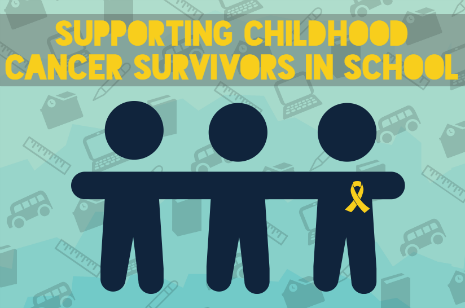By Lisa Carey and Maureen van Stone, Esq., M.S.
June 20, 2017

As mentioned in previous Linking Research to Classrooms Blog posts, the life-saving treatments for the two most common types of pediatric cancer (brain tumors and leukemia) can often negatively impact a child’s brain. Impacts can range from physical weakness and balance issues, to learning and attention difficulties. While it is important for classroom teachers to know and understand the impact cancer treatment may have on their students, it is also critical to recognize that policies and procedures within school systems can greatly impact academic and social outcomes for returning students. In this blog, we examine some tips for educators to better meet the needs of childhood cancer survivors.
Children may need formalized services and supports
For some children, cancer treatment may have a significant impact on their learning. Children who have undergone cancer treatment may be in need of special education and related services, which means they’re eligible for an Individual Education Program (IEP) under the federal code of “Other Health Impairment” (Individuals with Disabilities Education Act, 2004). School teams that are struggling to determine if a child is eligible for special education and related services after cancer treatment should collaborate with the child’s clinicians. In many cases, a consent for release of information between school staff and clinical staff can be obtained and used to improve educational planning and decision-making. The school team may also consider a 504 Plan for cases in which accommodations are necessary, but specialized instruction and related services are not required for the student to progress academically, socially, emotionally, or behaviorally.
Building a school team to support childhood cancer survivors
It is important for schools to build collaborative and interdisciplinary teams to support the needs of childhood cancer survivors transitioning back to school during or following their treatment. Classroom teachers should not be left to independently navigate the variable needs of students, who in many cases will have complicated medical, learning, and mental health needs. By creating an interdisciplinary team, each member can draw upon their expertise to inform their teammates and improve decision-making and problem- solving for the student. While some children will require more formal collaborative teams to support the development of an IEP or 504 Plan, informal teams can also be formed either prior to qualifying the student for these more formal supports, or at a time when the student’s educational impact does not warrant formalized services or supports.
Who should be on a support team?
In addition to the student’s classroom teacher, a support team may include school staff with expertise related to the identified needs of the student. For example, a school psychologist or social worker may be a vital team member for students who have experienced the ongoing stress of treatment and the additional stress of transitioning to the school setting after being away. Due to the ongoing medical needs of the student, a team member should also include the school nurse. The school nurse becomes even more vital for highly mobile students, as nursing records will travel between schools, even if the student does not have a formalized services and supports through an IEP or 504 Plan. Student support teams should consider identifying a “point person” for communication with non-school system medical staff, including oncologists, neuropsychologists, and social workers.
School – Home Communication is Vital
Hospitals and schools operate very differently. In the medical world, problems are quickly assessed, and treatment is prescribed rapidly. In schools, data are collected over longer periods of time and schools implement safeguards to prevent both the over and under identification of students with disabilities, which often preclude rapid assessment and intervention. Families transitioning between medical institutions and schools may find it difficult to move from one culture to the other. It is important that families are informed of education laws and policies, as well as the rationale behind educational practices. For example, in a hospital, a doctor may quickly write a prescription to address a need, whereas schools have a legal obligation for teams to evaluate students over time and collectively determine an intervention that will allow for the student to receive needed academic and related services in the least restrictive setting possible (Individuals with Disabilities Education Act, 2004). This difference in timing can cause feelings of frustration for families. Be patient. Explain things clearly and have open conversations to address concerns. Consistent communication regarding student progress can help ease tensions.
Summary
Regardless of the formal or informal services or supports required for a child to educationally thrive after cancer treatment, schools should consider the creation of interdisciplinary teams to improve their ability to problem solve around the changing needs of childhood cancer survivors. Developing clear systems of communication among families, school staff, and clinicians can greatly improve a school’s ability to proactively address student needs.















